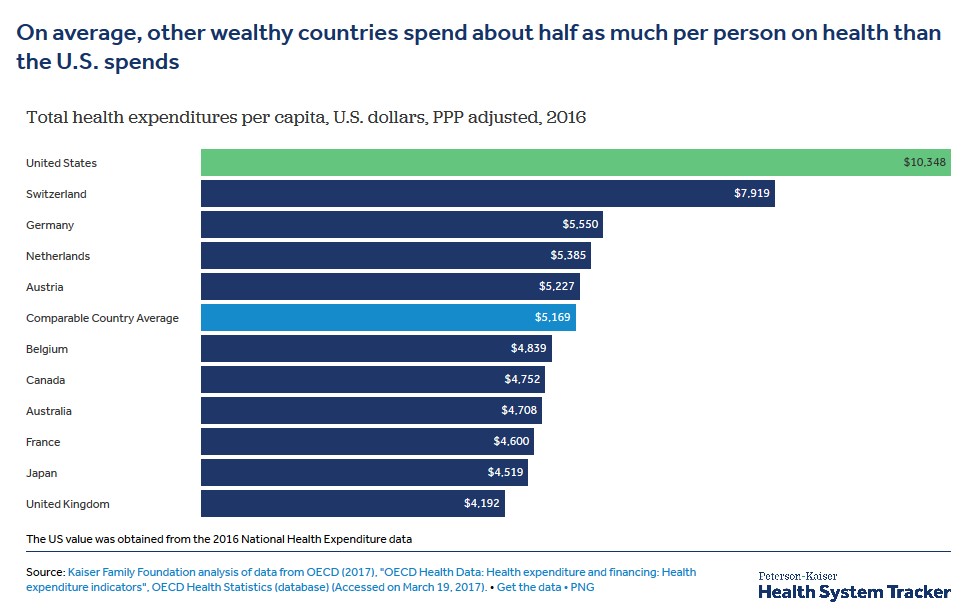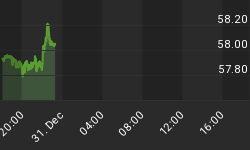America has a big, big problem on its hands. Healthcare costs are rising at astronomical and unsustainable rates, and the country’s leader seems powerless to stem the tide.
Perhaps that would not be a big problem if the economy was keeping pace. But it isn’t. In fact, growth in healthcare spending is projected to outflank economic growth by a factor of more than 2:1.
A Health Affairs study has projected U.S. health care spending to grow at 5.5 percent every year through 2026, compared to just 2.0 percent GDP growth over the timeframe.
The U.S. spent a staggering $3.3 trillion on health care in 2016, good for 17.9 percent of GDP. Compare that to the situation back in 1960 when the nation spent only $27.2 billion on the same, just 5 percent of GDP.
The U.S. might be the largest economy in the world, but it still spends a disproportionately large amount on healthcare. In 2016, health care expenditure per capita clocked in at $10,348--about double the average spend by other wealthy nations.

(Click to enlarge)
Source:HealthSystemTracker
But why is healthcare expenditure here so excessive? Related: Investors React To Escalating Trade War Drama
What really sets the U.S. apart are inflated prices across the board—drugs are more expensive, diagnostic tests and hospital services cost more and doctors get paid more. Plus, a lot of money goes into planning, managing and regulating medical services at the administrative level.
Learning From India’s Telemedicine
Maybe it’s time for the U.S. to start gleaning lessons from other countries where healthcare costs are more affordable. Countries like India.
Yes, a seemingly odd choice given the country’s abysmal public health record--largely unregulated, opaque and with quality state-run hospitals few and far between. India spends a little over 1 percent of GDP on public healthcare, one of the lowest in the world.
But the system is currently under rapid transformation under Prime Minister Narendra Modi’s new “Modicare” initiative. More importantly, India’s hospitals are increasingly using telemedicine to slash healthcare costs dramatically.
Dartmouth College professor Vijay Govindarajan and his counterpart, Center for Emerging Markets at Northeastern University’s director Ravi Ramamurti, contend that widespread adoption of telemedicine in the U.S. can potentially cut the healthcare budget by as much as 30-40 percent without rationing care or compromising quality.
They point at India’s Aravind Eye Care System, a private non-profit company, where a surgeon, with the help of two nurses, sits between two operating stations and is able to perform 5-6 surgeries an hour at a cost of just $100 per procedure. That compares favorably to just one or two procedures that the average US surgeon manages over the timeframe at a cost of $3,542 per procedure.
Govindarajan and Ramamurti also highlight Boston-based innovator Iora Health as an excellent case study. Iora Health has perfected a network of primary-care practices that have been successfully used to reduce hospitalizations for members by 40 percent and also managed to cut healthcare spending by 15-20 percent over the past five years. They also mention that the joint health care initiative between Amazon, JP Morgan and Berkshire Hathaway will be likely to achieve significant cost savings.
Related: 10 Countries Feeling The Heat As The Trade War Escalates
Further, the two researchers say that a change in healthcare regulation from fee-for-service to bundled pricing and other risk-sharing arrangements can encourage both hospitals and entrepreneurs to deliver more healthcare innovations.
Attitude Adjustment
Ultimately, an attitude change by the American public is required if the proposed initiatives are to succeed.
It’s funny how Americans squawk at the idea of assembly-line medicine yet happily accept eating at fast-food restaurants, flying budget airlines and buying cookie-cutter homes. Southwest Airlines is not famous for coddling its passengers but rather for providing safe, punctual and affordable air transportation.
An efficient healthcare approach can significantly lower insurance premiums and copays without compromising on quality.
By Alex Kimani for Safehaven.com
More Top Reads From Safehaven.com:

















